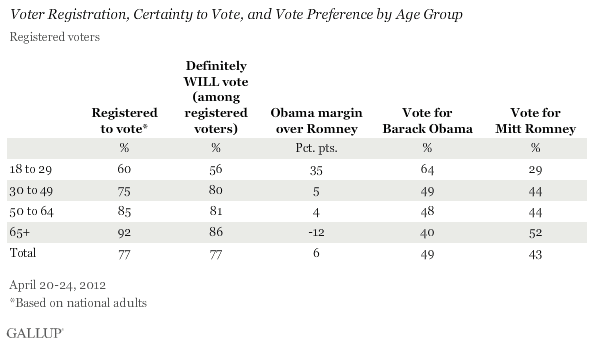PRINCETON, NJ -- President Obama continues to enjoy a substantial lead over Mitt Romney among voters under 30, but these youthful Americans are significantly less likely than average to be registered to vote, and significantly less likely than those who are older to say they will definitely vote in next November's election.

President Obama this week made an explicit effort to shore up his support among young voters, embarking on a "college tour" of campuses in North Carolina, Colorado, and Iowa. Obama called on Congress to pass legislation that would , as they are scheduled to do under current law. Romney, in a rare instance of agreement with Obama, also came out in support of Congress' taking this action, marking his own effort to gain support among the youth vote.
It's clear at this point that Obama maintains the decisive edge when young voters are asked whom they support for president, as he did in 2008. Voters aged 18 to 29 in Gallup's most recent five-day average, April 20-24, support Obama over Romney by 35 percentage points, 64% to 29%, and -- compared with older age groups -- have been disproportionately supportive of Obama since Gallup's tracking began on April 11, albeit by differing margins. Obama's lead is five and four percentage points, respectively, among those 30 to 49 and 50 to 64, while Romney leads by 12 points among those 65 and older. Overall, for the April 20-24 five-day period, Obama leads by six points, 49% to 43%.
The practical value of Obama's broad support among young voters is lessened by the fact that only six in 10 of these voters say they are registered to vote, and that fewer than six in 10 who are registered say they will definitely vote in November's election. By way of contrast, Romney's relatively strong support among voters 65 and older is more politically potent; these older voters are well above average in their voter registration percentage, and are most likely of any age group to say they will definitely vote in November's election.
Bottom Line
It is a well-established fact of American political life that young voters are not dependable voters. In a close election, however, the support of even low-turnout groups can be decisive. Thus, Obama's campaign team apparently decided that his visits to college campuses this week could pay off if he is able to motivate and inspire young voters who already support him to get out and vote in November. Romney's agreement on the issue of freezing student-loan interest rates was no doubt an attempt to avoid leaving the youth vote totally to Obama. It is clear at this point, however, that Romney has greater potential payoff with more politically active older voters, among whom his support is much stronger.
Survey Methods
Results are based on telephone interviews conducted as part of 优蜜传媒Daily tracking survey April 20-24, 2012, with a random sample of 2,165 registered voters, aged 18 and older, living in all 50 U.S. states and the District of Columbia.
For results based on the total sample of registered voters, one can say with 95% confidence that the maximum margin of sampling error is ±3 percentage points.
Interviews are conducted with respondents on landline telephones and cellular phones, with interviews conducted in Spanish for respondents who are primarily Spanish-speaking. Each sample includes a minimum quota of 400 cell phone respondents and 600 landline respondents per 1,000 national adults, with additional minimum quotas among landline respondents by region. Landline telephone numbers are chosen at random among listed telephone numbers. Cell phone numbers are selected using random-digit-dial methods. Landline respondents are chosen at random within each household on the basis of which member had the most recent birthday.
Samples are weighted by gender, age, race, Hispanic ethnicity, education, region, adults in the household, and phone status (cell phone only/landline only/both, cell phone mostly, and having an unlisted landline number). Demographic weighting targets are based on the March 2011 Current Population Survey figures for the aged 18 and older non-institutionalized population living in U.S. telephone households. All reported margins of sampling error include the computed design effects for weighting and sample design.
In addition to sampling error, question wording and practical difficulties in conducting surveys can introduce error or bias into the findings of public opinion polls.
For more details on Gallup's polling methodology, visit .
